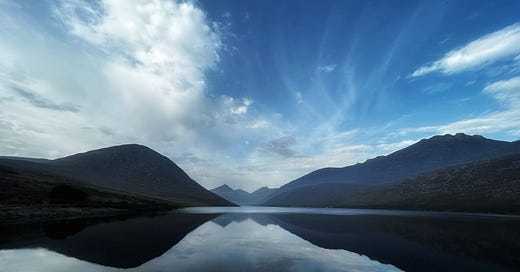Welcome to Regen/ Notes.
I am using twenty-fifty with two significant meanings here. In the first case, a personal significance in that it was fifty years ago this month that I started what has been an brilliant career in the built environment, and just under 20 years since I started my consultancy Fairsnape to support others on what we now see as a sustainability and regenerative journey
And secondly, the current generic significance for 2050 is the date we have been given or have chosen for carbon neutrality.
An Energy Start
My career started as a QS in the city of Bath following a woefully low number of ‘O Levels’ (for those who remember them - the predecessor to GCSEs). It was a start in the industry at a time shaped by energy, or rather,the lack of supply. My first construction project, a housing estate in Bath, was subject as all industries to a ration of only three days of energy per week. Quantity surveying by candlelight anyone?

A year or so later I found myself in Scotland at the Portavadie dry dock accommodation village construction. It was a key element in the UK’s failed Energy Strategy for oil rig construction. It was never used, leaving what was later labelled the world’s largest man-made hole. Yet, as a marina, it has become a popular holiday destination. One I have cycled through a few times on the Five Ferry island-hopping cycle ride. The accommodation village remains a ghost village.
Since that start, fifty years in construction have provided me with a real wealth of experiences and insights that I share and give back through Fairsnape and other organisations such as Living Future Europe, these regenerative Notes and of course Zoom Regenerative.
Naming my organisation Fairsnape, named after a local hill here in the Forest of Bowland, enables me to weave passions of nature and outdoor activity into support for a (built environment) regenerative future through for example nature-positive and biophilia.
1978 saw me returning to education to take a degree, followed by working in the USA, in the Caribbean, project managing large complex UK industrial projects, leading on business improvement issues for major contractors, contributing to the shape of collaborative working in our sector and aligning fm and construction approaches through PFI’s. Taking major contractors through environmental management in the 1990s (ISO 14001 - then BS5750) shaped the move into sustainability and where I am today with regenerative support through Fairsnape.
Health and Safety at Work
However back to 1973 as a significant year.
I am attending my first industry awareness conference. I recall listening to manager's arguments for and against the introduction of the Health and Safety at Work Act (HASAWA) that was to be introduced in 1974. It really was a political hot potato, tied into the influence of unions and industrial relations (IR) at that time. (The theme of my thesis many years later).
In favour, was the call for stronger protection for workers and clarity on Health and Safety. I recall a dominant opposition over concerns on financial burden, increased operational costs and of course perceived bureaucratic administrative work.
Prior to the HASAWA, there were many separate pieces of legislation governing health and safety in different industries. These laws were often inconsistent and inadequate in addressing workplace risks. The prevailing approach to safety was reactive, with a focus on addressing accidents after they occurred rather than preventing them from happening in the first place.
It was a pivotal piece of legislation in the UK that brought about significant changes in the approach to workplace health and safety. It introduced a more comprehensive and proactive framework, placing legal obligations on employers and emphasising prevention, worker involvement, and enforcement. Its impact extended beyond the UK, influencing health and safety laws globally.
And so to the current significance placed on the year 2050.
The Paris Agreement, adopted at COP21 in 2015, called for efforts to limit global warming to well below 2 degrees with an aim to limit the increase to 1.5 degrees.
“a balance between anthropogenic emissions by sources and removals by sinks of greenhouse gases in the second half of this century.”
Organisations and countries perhaps mistakingly have interpreted this as a goal to achieve carbon neutrality by 2050.
Hows that 2050 Journey to Carbon Neutrality Going?
Creating a HASAW-style umbrella system thinking Act that aligns the myriad of legislations and initiatives on climate issues, and places real legal obligations on employers could give a similar transformative and proactive step toward achieving climate action.
There is the brilliant adage that if we wait for legislation it will be too late, if we act alone it will take too long, if we act as communities we will get results. But in the urgency of the perma-crisis we face, maybe we need all approaches and that 'one ring to rule them all' approach that gives clarity on climate actions.
Zoom Regenerative 58
"one of the most important aspect of regenerative business today is to inspire and empower future generations, projects and ideas to reach higher, to be bolder and to be far, far more distruptive" Martin Brown RESTORD2030
Zoom Regenerative returns on 19th Sepetmber and delighted to welcome Alison Watson at Class of Your Own, sharing insights from her work to EMPOWER and EDUCATE young people everywhere, so they can design, engineer and construct an EXTRAORDINARY future.
Plus our meet & greet speed breakouts and great ZR regenerative conversations
Why 2050 as a carbon-zero date?
Setting a target for achieving carbon neutrality is a crucial step in addressing the global climate crisis. There is much debate about whether this should be 2050 or earlier. Looking around the world at the shifting climate-driven weather patterns and disasters quicker and more radical approaches will surely become vital.
And that 2050 route map … should not or will not a simple linear route, but one that will be complex, interconnected with many strands.
Here are 20 aspects giving a glimpse into what achieving carbon neutrality by 2050 (or your chosen 20XX date) entails:





